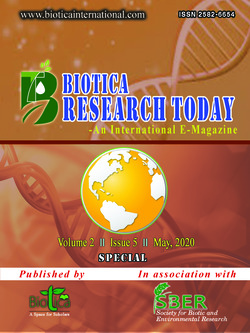
Impact of Agriculture Crop Residue Burning on Environment and Soil Health
Rohitashav Nagar*
Department of Agronomy, School of Agricultural Sciences, Career Point University, Kota, Rajasthan (324005)
Dr. S. K. Trivedi
Department of Agronomy, School of Agricultural Sciences, Career Point University, Kota, Rajasthan (324005)
Deepak Nagar
Department of Agronomy, School of Agricultural Sciences, Career Point University, Kota, Rajasthan (324005)
Dr. Monika Karnawat
Department of Agronomy, School of Agricultural Sciences, Career Point University, Kota, Rajasthan (324005)
DOI: NIL
Keywords: Crop Residue, Burning, Environment, Soil Health
Abstract
There are 115 million operational holdings in the country and about 80 % are marginal and small farmers. To fulfil the basic needs of house hold including food, feed, fodder, fibre, etc. were an attention about bio intensive cropping system (BICS). Global warming and its consequences are amongst the most serious problems of the present century. Agricultural crop residue burning contribute towards the emission of greenhouse gases (CO2, N2O, CH4, CFCs), air pollutants (CO, NH3, NOx, SO2, NMHC), volatile organic compounds, particulates matter and smoke thereby posing threat to human health. Total amount of residue generated in 2008– 09 was 620 Mt out of which ~15.9% residue was burnt on farm. Rice straw contributed 40% of the total residue burnt followed by wheat straw (22%) and sugarcane trash (20%). Conservation agriculture and recommended management practices (RMPs) collectively are helpful to offset part of the emissions due to unscientific agricultural practices.
Downloads
not found
Reference
Araya T, Cornelis WM, Nyssen J, Govaerts B, Bauer H, Gebreegziabher T, Oicha T, Raes D, Sayre KD, Haile M and Deckers J, Effects of conservation agriculture on runoff, soil loss and crop yield under rainfed conditions in Tigray, northern Ethiopia. Soil Use Manage., 27, 404–414, (2011).
Bertol OJ, Rizzi NE, Bertol I and Roloff G, Soil and water loss and quality of surface runoff associated with interrill erosion in no- tillage area treated with chemical and organic fertilizers. Rev. Bras. Cienc. Solo, 31, 781– 792, (2007).
Thakuria D, Talukdar NC, Goswami C, Hazarika S, Kalita MC and Bending GD, Evaluation of rice–legume–rice cropping system on grain yield, nutrient uptake, nitrogen fixation, and chemical, physical, and biological properties of soil. Bio Fertility Soils, 45: 237–251, (2009).
